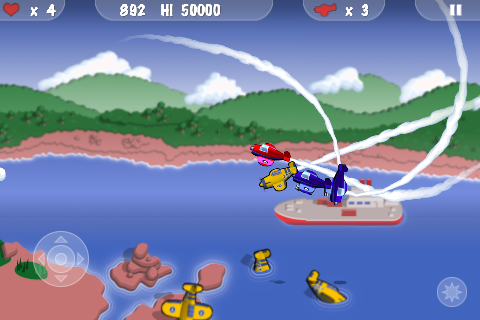Along with iPhone smash hits such as Fruit Ninja and Flick Kick Field Goal, OpenFeint’s arrival on Android has brought with it one or two games that are easily as good, but didn’t enjoy half as much success as they deserved on the Apple platform.
A simply brilliant arena blaster set in a fantastically realised world where biplanes still rule the skies, it deserved to be a far bigger hit than it was.
Thankfully, it now has a second shot at glory on Android. Equally good news is that it’s made the transition almost intact.
The idea is to fly your little biplane around each arena using a virtual scroll wheel, shooting waves of rivals out of the sky using your right thumb. Occasionally power-up stars fall from the sky, granting you (or your enemies) limited-use abilities such as rapid fire or whopping great lasers.
MiniSquadron’s main appeal is in its handling model. Your plane swoops and loop-de-loops with semi-realistic grace, making every level a thrilling game of cat and mouse as you jostle for position with the excellent AI pilots.
This is aided by a fine approximation of aerial warfare physics, so attacking from above provides a genuine advantage owing to the increase in speed it grants you.
With such a nuanced dogfighting system, the inclusion of a local wi-fi multiplayer mode is most welcome.
There’s compelling reason to progress through the game’s generous Classic mode (eight levels, each containing 12 waves) too, in the shape of 56 unlockable planes. Each craft has its own unique attributes, including size, speed, armour, turning speed and weapon type. They handle almost as uniquely as they look.
It’s not quite the perfect conversion we were hoping for, though. Playing on a Motorola Milestone, the graphics came across as slightly blurry and low-res on the larger, sharper screen, suggesting the game hasn’t been fully optimised.
This is confirmed by the fact that the game doesn’t run as smoothly on this device as it does on a second generation iPod touch.
The game’s less responsive controls are doubtless a result of inferior multi-touch technology, which probably led to the decision to place the fire control at the top right of the screen (diagonally opposite the movement controls). It’s understandable, but it does make things a little awkward.
Still, MiniSquadron’s inherent quality shines through such minor complaints. It’s a fluid, addictive gem of an arcade blaster with bags of hidden depth, and it deserves a large audience.








No comments:
Post a Comment